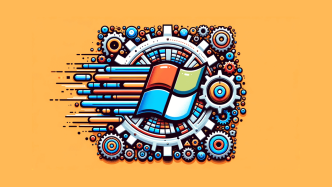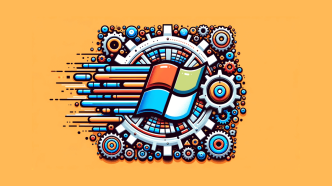Working together isn’t what it used to be. The era of crowding around a conference table with sticky notes and dry-erase markers is fading fast. Today, it’s all about collaboration platforms, where teams can connect, brainstorm, and get stuff done—whether they’re in the same office or spread across time zones. With a smorgasbord of options out there, how do you pick the right one? Trust me, I’ve spent hours digging through the web and testing multiple platforms to give you a lay of the land.
Today, we’re talking all things collaboration platforms. These are the digital spaces where your team can chat, share files, allocate tasks—you name it. They’ve exploded in popularity, especially as remote work has become the norm rather than the exception. But just like every tool isn’t a hammer, not all collaboration platforms fit every team’s needs. You’ve got big names like Slack and Asana, and then there are the under-the-radar gems that deserve a second look.
To make your life a tad easier, I’ve narrowed down some of the best platforms for different kinds of teams. Whether you’re a small business looking to keep your team nimble, or a larger operation wanting to streamline a ton of moving parts, there’s something here for you. And yes, I’ve taken the time to look at what makes each platform tick, so you won’t be left scratching your head.
What other apps do you need to run your team operations smoothly?
So you’re about to have your collaboration platform needs sorted, but what about the rest of your toolkit? Believe it or not, running a smooth operation involves more than just nailing down a great space for teamwork. There’s a whole suite of apps and tools out there that could be game-changers for how your team operates.
For example, you might be wondering how to secure all the data you’re now sharing and storing online. If that’s a burning question for you, you’ll definitely want to check out my article on the latest data security software that can keep your digital workspace safe. Or perhaps you’re curious about automating tedious, repetitive tasks? I’ve got a deep-dive article on workflow automation tools that can make your day-to-day more efficient.
And don’t even get me started on project management. If you’re juggling multiple projects, timelines, and deliverables, you’ll find my comprehensive guide to project management software invaluable. These articles are designed to give you the lowdown on tools that can complement your chosen collaboration platform and help your team achieve its fullest potential.
Now, let’s break down what makes each of these collaboration platforms unique, how they can make your team more productive.
Zulip
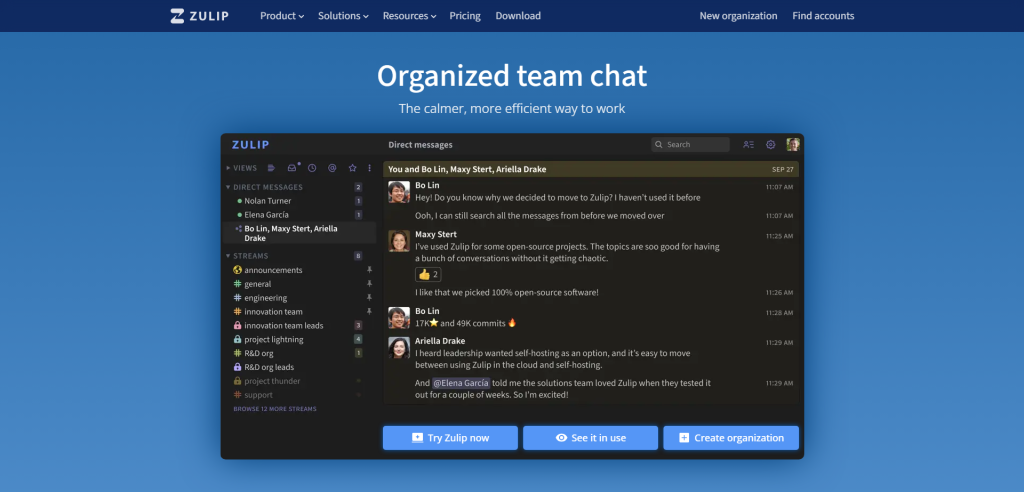
Unlike other chat apps, Zulip allows you to read and respond to every message in context, no matter when it was sent. This means that you can maintain your focus and catch up on your own time without stress, only reading the topics that you care about.
The threading model in Zulip makes it much easier to manage teams. As a leader, you can quickly get an overview of what’s going on and see where your attention is needed. This helps you stay in control and effectively collaborate with your team.
One of the best features of Zulip is its ability to handle collaboration at scale. It doesn’t matter if you have a small team of friends or a globally distributed organization with hundreds of people, Zulip is designed to make teams more productive together. A signifcant advantage of this app is that it can handle hundreds of conversations.
Zulip also offers enterprise-ready features and controls. You can take charge of your mission-critical communications with Zulip’s reliable and open-source software. There is no vendor lock-in, and you can self-host Zulip for ultimate control and compliance. It offers various security features, including SAML authentication, LDAP sync, fine-grained permissions, and GDPR compliance.
👍 Pros
- Allows reading and responding to every message in context, maintaining focus and catching up on your own time.
- Makes it easier to manage teams with its threading model.
- Handles collaboration at scale, making it manageable to handle hundreds of conversations.
👎 Cons
- Some users may find the learning curve steep due to the advanced features and controls.
- The interface may feel overwhelming for users who are accustomed to simpler chat apps.
- Customizing and configuring Zulip to fit specific workflows may require technical knowledge.
Users have praised Zulip for its smart and powerful functionality. It has been described as everything Slack is, but smarter and more powerful. It has also been credited with driving the development of the Rust programming language. Users have noted that Zulip’s topics make it easier to keep things coherent in educational and research settings.
Miro
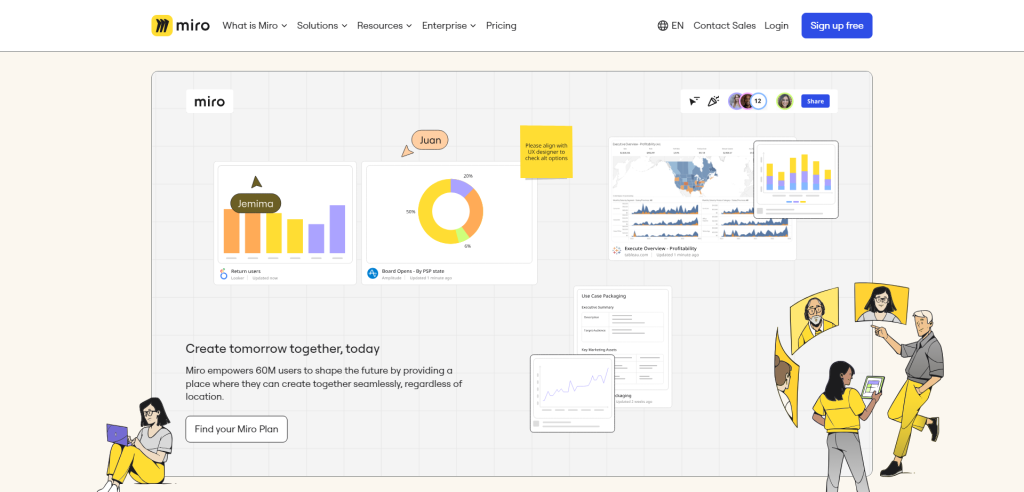
Miro is a visual workspace for innovation that allows teams to collaborate seamlessly and create together, regardless of their location. It offers a range of capabilities designed to accelerate innovation and improve productivity.
What sets Miro apart is its ability to provide a single, integrated workspace for teams to work on various aspects of their projects. Whether it’s strategizing and planning, designing customer-centric solutions, or developing products and services, Miro has the tools to support every stage of the innovation process.
One key feature of Miro is its workshops and asynchronous collaboration capabilities. Teams can gather feedback and make decisions more efficiently by bringing together slides, real-time data visualizations, action items, and diagrams on a single board. This helps foster deep collaboration and speeds up the feedback cycle.
Miro also excels in diagramming and process mapping. Its intuitive and user-friendly workspace allows teams to visualize complex systems, ideas, and organizational structures. By automating time-consuming tasks and providing a platform to bring products and software to market more efficiently, Miro helps teams save time and streamline their work processes.
The Miro AI feature is another standout aspect of the tool. It leverages the latest models to automate tedious tasks and expand thinking during ideation and creation. This speeds up work and allows teams to focus on analysis, alignment, and execution.
Users have praised Miro for its ability to bring teams together and improve collaboration. Customers such as PepsiCo, Asos, and CD PROJEKT RED have seen significant benefits from using Miro, including faster time to market, improved planning, and better alignment between teams.
To make work even more efficient, Miro integrates with over 130 tools, including Jira, Azure DevOps, Asana, Zoom, Teams, and Slack. This allows teams to streamline their workflows and access their favorite tools directly within the Miro workspace.
TWAKE
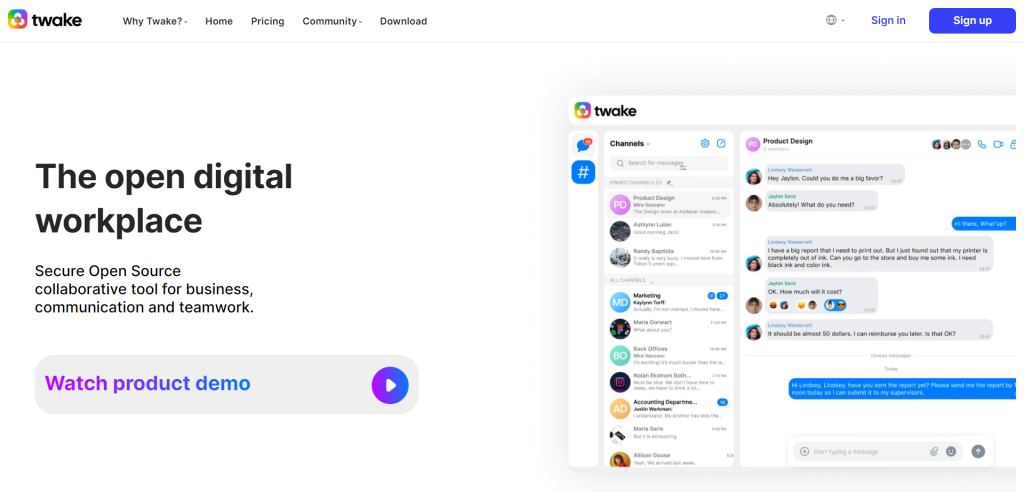
Twake is an open-source digital workplace tool that aims to enhance collaboration, communication, and productivity for teams. With its focus on being secure, private, and GDPR compliant, Twake offers unique features that set it apart from other collaborative tools.
Twake is an all-in-one solution, which includes a messenger for seamless communication, a disk and sharing solution for secure file storage and collaboration, integration with office tools to streamline work processes, and video conferencing capabilities for virtual meetings. This comprehensive approach makes Twake a convenient and efficient tool for teams to manage their activities in one centralized hub.
Twake prioritizes the privacy and security of user data. The platform encrypts the database and files, giving users complete control over who can access their data. Additionally, all data is stored in France, ensuring compliance with GDPR regulations. Secure transfers using HTTPS/SSL and end-to-end websockets communications add an extra layer of protection.
By offering an open-source platform, Twake encourages community contribution and ethical design. Users can collaborate on the development of the tool, ensuring that it meets their unique needs and contributing to a positive impact on the world. In line with this, Twake has pledged to be carbon-free by 2030, aligning with the goal of sustainability.
👍 Pros
- All-in-one solution for seamless collaboration
- Emphasis on privacy and security, with encrypted data and storage in France
- Open-source platform that encourages community contribution and ethical design
👎 Cons
- Limited user feedback available
- Less well-known compared to more established collaborative tools
- Integration with certain office tools may require coding knowledge
Users of Twake have expressed their appreciation for the platform, emphasizing its effectiveness in project management, ease of use, and the ability to invite relevant collaborators or customers.
Users have also commended the solution for gathering digital tools beyond the traditional offerings, making it a versatile and competitive option.
Asana
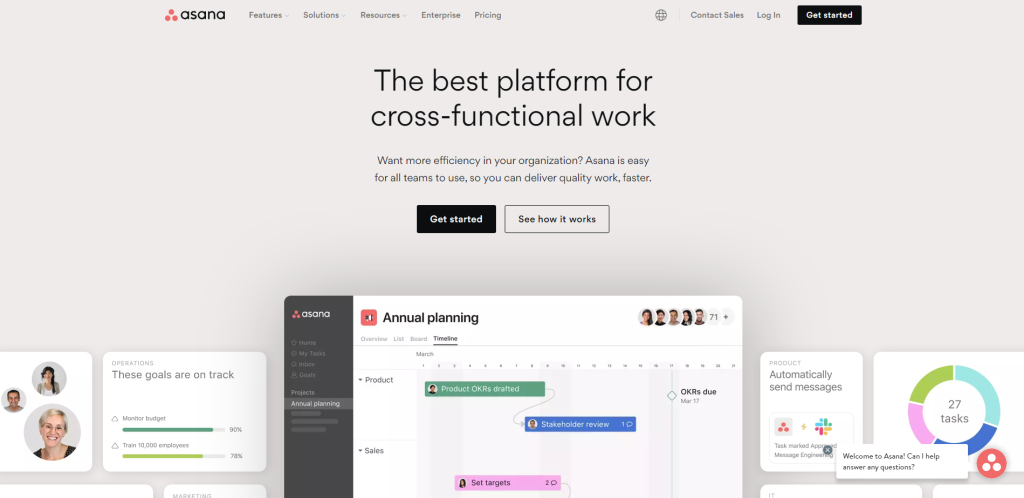
Asana is a powerful online project management tool that helps teams collaborate, coordinate tasks, and hit deadlines. Its flexibility and ease of use make it a popular choice for teams looking to improve productivity and efficiency.
One of the unique features of Asana is its integration of AI, known as Asana Intelligence, which amplifies your team’s impact by automating processes and providing real-time insights into progress. With Asana Intelligence, you can create automated workflows, build beautiful Gantt charts, track work on Kanban boards, and more. It also offers a wide range of app integrations, allowing you to bring all your favorite work tools together in one place.
Asana is highly praised by users for its cross-team collaboration capabilities and its simplicity of adoption. It allows teams to connect what needs to get done, who’s doing it, and when, making it easy to prioritize and manage complex work.
👍 Pros
- Flexible and easy to use
- Offers AI-powered automation and real-time insights
- Integrates with over 200+ apps
👎 Cons
- Can be overwhelming for users who are not familiar with project management principles
- Some users find the interface to be cluttered and difficult to navigate
- Pricing plans can be expensive for small teams
Users also appreciate the ability to streamline workflows, automate tasks, and gain real-time insights into progress. In fact, 80% of Fortune 100 companies use Asana to drive efficiency across their organizations.
Freedcamp
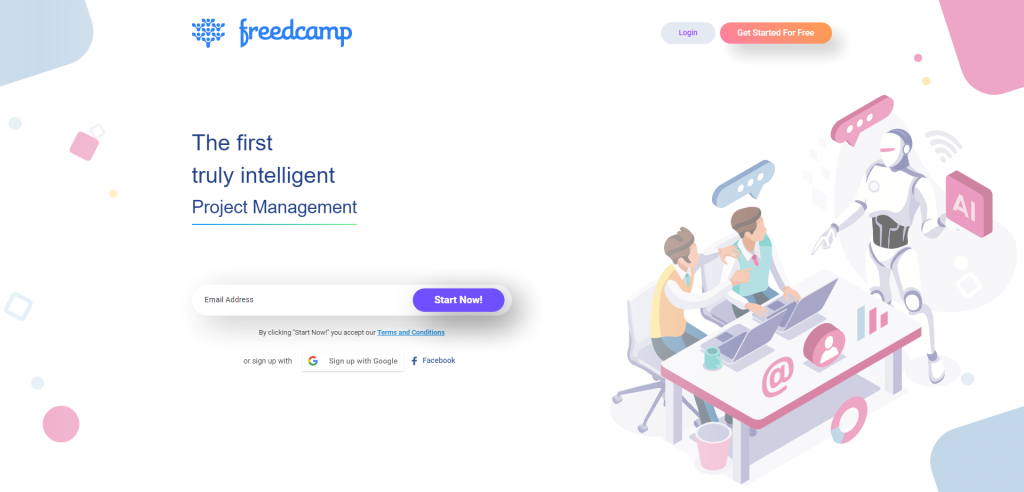
Freedcamp is a free project management tool that aims to make your life easier by providing all the necessary features to effectively manage projects, regardless of complexity or business size. Unlike other project management solutions that can be clunky and time-consuming to work with, Freedcamp offers an intuitive interface that streamlines file editing and saves you time. With features like customizable permissions, notifications, and system management, you have the flexibility to control and personalize your workspace to suit your team’s needs.
One unique aspect of Freedcamp is its dedication to customer support. Unlike larger companies, you’ll be dealing with a small, dedicated team that includes the decision-makers. This means faster response times when reporting bugs or requesting custom features. The support team is available 24/7 to answer your questions and help you navigate the platform.
Users appreciate the robust functionality and customizable nature of Freedcamp. The platform integrates task, project, and time management apps seamlessly, making it a valuable tool for both internal and external teams/projects. The ability to customize your workspace with different views, filters, and permissions allows for friction-free workflows and efficient project organization.
👍 Pros
- Intuitive interface and customizable workspace
- Seamless integration of task, project, and time management apps
- Excellent customer support
👎 Cons
- Limited functionality compared to more advanced project management tools
- Learning curve for new users
- Interface may feel cluttered at times
Freedcamp offers a strong free plan with unlimited storage, users, and control over permissions, making it an ideal choice for individuals or teams just starting out. However, even as your business grows, Freedcamp’s advanced tools and analytics in their Enterprise plan can support your needs.
Lumeer
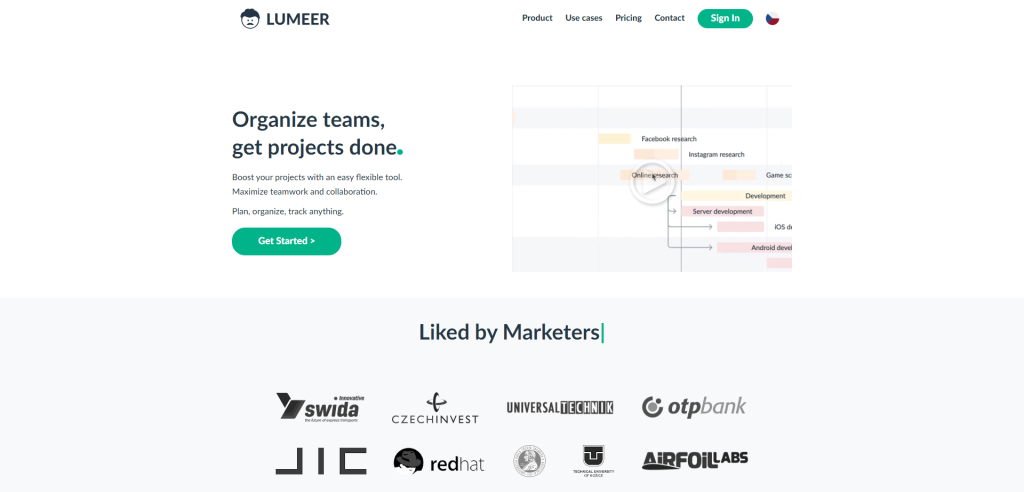
Lumeer is a visual and easy project and team management tool that aims to boost productivity and enhance collaboration within teams. This tool stands out due to its flexibility and the range of use cases it supports.
With Lumeer, you can organize and track everything related to your projects and teams in one place. Whether it’s tasks, clients, projects, features, bugs, invoices, inventory, budgets, or expenses, you can connect and manage them effortlessly. If you’re familiar with using spreadsheets, you’ll find Lumeer easy to navigate as well.
One of the unique aspects of Lumeer is its ability to automate routine work and unleash your team’s creative potential. You can create a customized workflow, automate repetitive manual tasks, minimize errors, and track your progress effectively. Users have praised Lumeer for its ease of use and its ability to improve organization and free up time for more important tasks.
Lumeer integrates seamlessly with over 3000 existing tools, allowing you to leverage your preferred applications and enhance productivity. Collaborating with different teams and individuals becomes more streamlined, regardless of their location. Users have reported that integrating Lumeer with email, for example, has greatly improved real-time team collaboration and focus on results.
With Lumeer, you gain a 360-degree view of your projects, enabling you to see the big picture and access the information you need when you need it. The tool provides various visualizations such as timelines (Gantt charts), calendars, boards (Kanban), workflows, charts, maps, and pivot tables, allowing you to tailor your view according to your preferences.
Lumeer is suitable for any process, department, industry, and team size. It offers a wide range of use cases, including task management, client projects, project management, sales pipeline management, remote work, and agile projects.
Slab
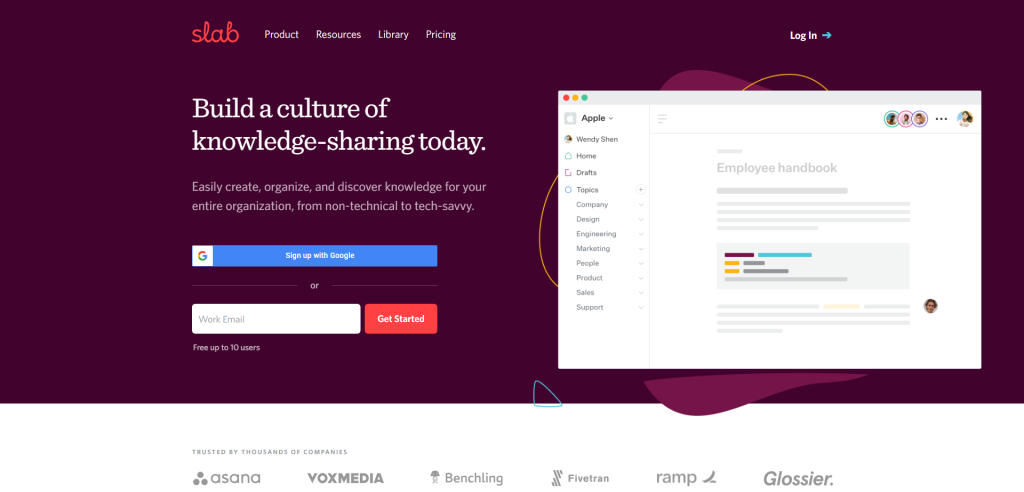
Slab is a knowledge base and wiki software that aims to create a culture of knowledge-sharing within organizations. It provides a platform for creating, organizing, and discovering knowledge, catering to everyone in the organization from non-technical to tech-savvy individuals.
What makes Slab unique is its focus on making content creation easy and visually appealing. The tool offers modern editing capabilities within an intuitive interface, allowing users to focus on writing without the need for extensive formatting fixes. This feature saves time and ensures that the knowledge base looks professional right from the start.
One of Slab’s key strengths lies in its organization capabilities. While traditional folder and tag systems are often insufficient, Slab Topics provide both organization and relevant context. This makes it easy for teams to learn about company policies, procedures, and each other’s ideas and insights. Users can easily navigate through topics and discover relevant information, improving efficiency and collaboration within the organization.
A standout feature of Slab is its powerful search functionality. It’s not just another place to search, as it integrates with all of the user’s integrated tools through Unified Search. This means that users can conveniently find answers from Slab content and other integrated tools, all in one place. This streamlines the search process and saves time by eliminating the need to switch between multiple platforms.
Slab’s integration capabilities are also worth mentioning. It doesn’t aim to replace other tools in your tech stack but rather integrates seamlessly with them. Whether it’s spreadsheets, slide decks, flowcharts, or task managers, Slab can connect with your favorite tools, ensuring a cohesive workflow. Moreover, if you’re switching from another platform, Slab offers assistance in migrating your data, making the transition smoother.
Focalboard
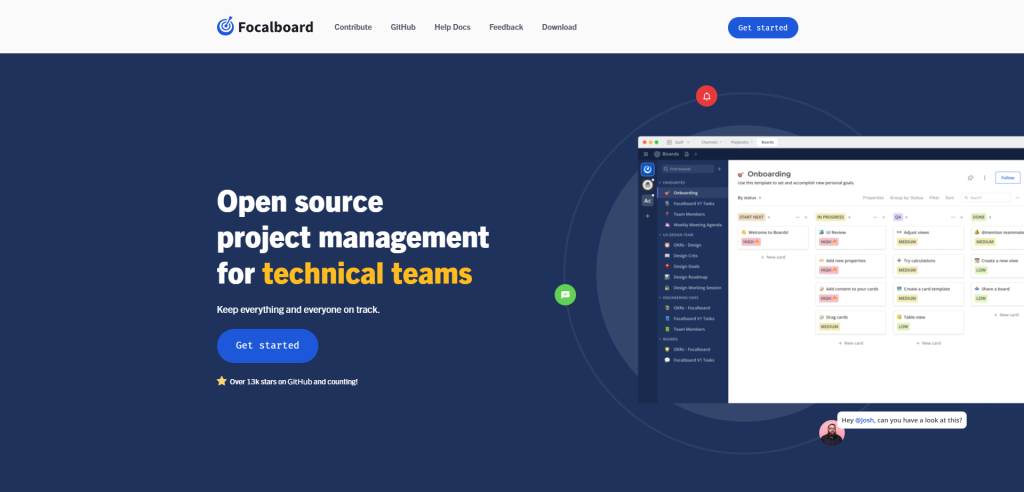
Focalboard is a powerful open-source project management tool designed specifically for technical teams. Whether you’re a software development team, IT department, or any other technical team, Focalboard can help you keep everything and everyone on track.
What makes Focalboard unique is its open-source nature. It is a free and customizable alternative to popular project management tools like Trello, Asana, and Notion. With the source code available on GitHub, you have the freedom to modify and customize the tool to fit your team’s specific needs. This gives you complete control over the tool and allows you to create a truly tailored project management experience.
One of the main benefits of using Focalboard is its ability to centralize and streamline your team’s work. With Focalboard, you can maintain a single source of truth, ensuring that everyone in your team is aligned and working towards the same goals. The tool provides a variety of views, including Kanban, table, gallery, and calendar, allowing you to organize and visualize your work in a way that suits your preferences.
Focalboard also promotes real-time collaboration, helping your team stay in sync. You can easily leave comments on cards, @mention teammates to get their attention, and set board permissions to share your boards with the entire team or specific individuals. This fosters a collaborative environment where everyone can contribute and stay updated on project progress.
Users of Focalboard appreciate its flexibility and customization options. The tool offers a wide range of templates to get you started quickly, or you can create a fully custom board from scratch. You can also take advantage of features like unlimited boards, file sharing, customizable attributes, and priority labeling to tailor Focalboard to your specific workflow.
👍 Pros
- Open-source and customizable
- Centralize and streamline work for technical teams
- Real-time collaboration and customization options
👎 Cons
- Requires technical expertise for customization
- Limited integrations compared to some proprietary tools
- Steeper learning curve for new users
WeKan
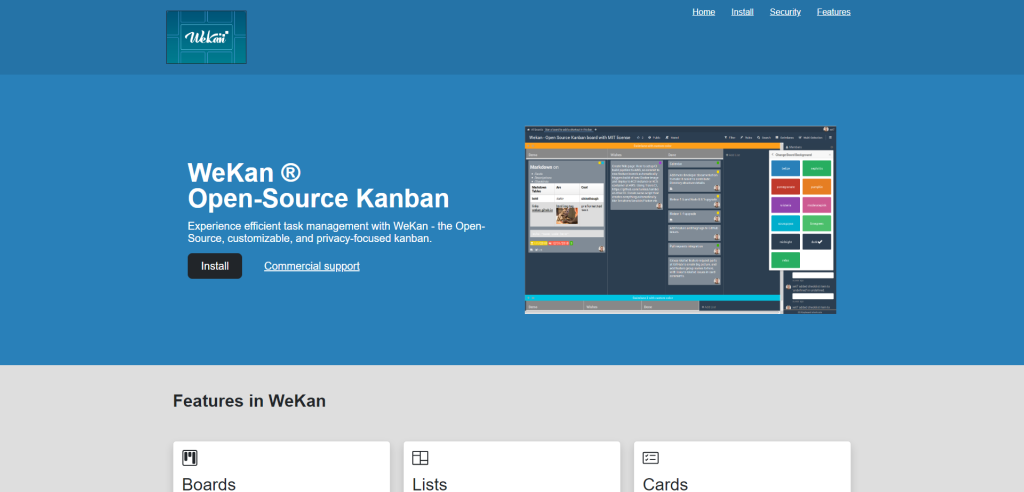
WeKan is an open-source kanban tool designed to streamline task management and improve team productivity. Its customizable and privacy-focused features make it stand out from other kanban tools in the market.
With WeKan, you can create multiple boards for different projects or tasks. Each board can have columns representing various stages of work, such as “To Do,” “Doing,” and “Done.” You can add cards to each board, which act as tasks with titles, descriptions, and due dates. This visual representation helps you keep track of your tasks and projects effectively.
One unique feature of WeKan is its emphasis on security. It offers a self-hosting option, giving users more control over their data and ensuring better security. By running the software on your own servers, you can have full control over your data and prevent unauthorized access. WeKan also allows you to set up access controls, limiting who can view and edit your boards and cards.
Being an open-source project, WeKan’s source code is available for inspection, reducing the likelihood of hidden security vulnerabilities. It is designed with security in mind and provides features and options to protect your data.
However, like any tool, WeKan has its drawbacks. Some users have mentioned that it lacks certain advanced features found in proprietary kanban tools. Additionally, while WeKan is actively maintained, some users have experienced difficulties with bugs or issues that require immediate attention.
👍 Pros
- Open-source and customizable
- Self-hosting option for greater data control
- Privacy-focused with access controls to protect sensitive information
👎 Cons
- Lacks certain advanced features found in proprietary tools
- Some users have experienced bugs or issues requiring immediate attention
- Limited to the features available in the current version
Kanboard
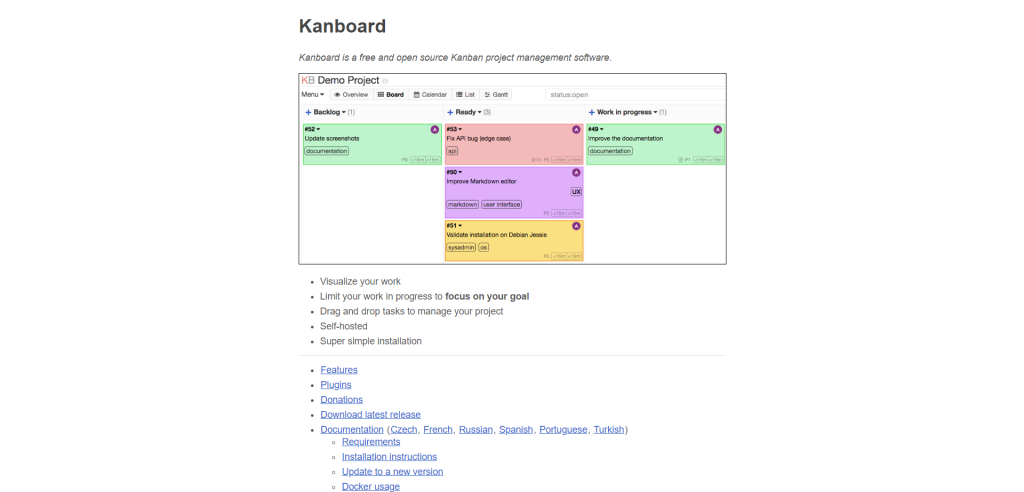
Kanboard is a free and open-source Kanban project management software that offers a simple and minimalistic approach to organizing and visualizing your work. With its drag-and-drop functionality, customizable board, and powerful search and filter capabilities, Kanboard helps teams stay focused and productive.
One of the unique aspects of Kanboard is its emphasis on simplicity. Unlike other project management tools that overload you with features, Kanboard keeps it streamlined, offering only the essential functionalities needed for effective project management. This simplicity makes it easy to understand and navigate, eliminating the need for extensive training.
The Kanban board is at the heart of Kanboard’s visual approach. It provides a clear overview of your tasks, allowing you to see the current status of your project at a glance. With the ability to add, rename, and remove columns, you can customize the board to match the specific needs of your project.
In order to increase efficiency and productivity, Kanboard encourages limiting your work in progress. By setting a maximum limit for each column, Kanboard helps you avoid multitasking and maintain focus on completing tasks. When you exceed the limit, the column is highlighted, alerting you to potential bottlenecks.
Kanboard also offers a powerful search and filter feature, allowing you to quickly find specific tasks based on assignees, descriptions, categories, due dates, and more. The simple query language makes it easy to create custom filters and dynamically apply them to the board.
Mural
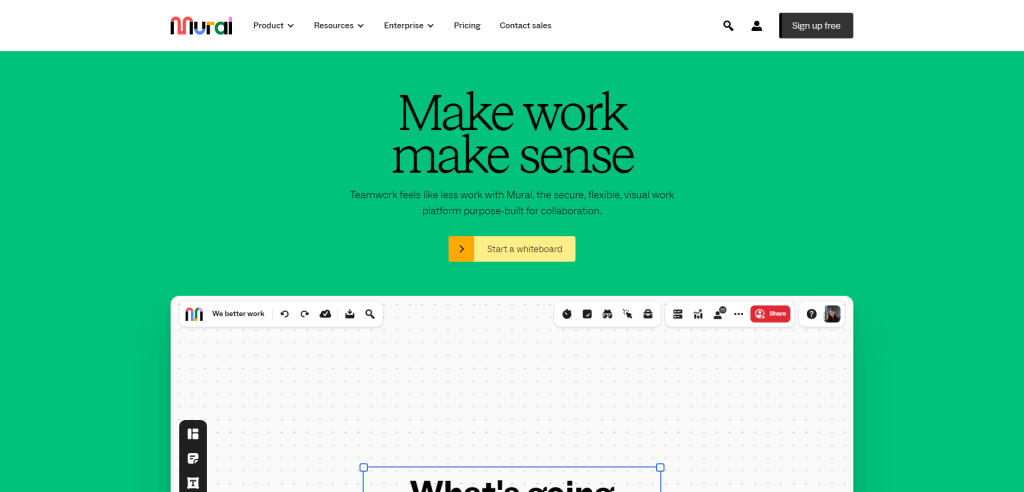
Mural is a visual work platform that is designed to make teamwork more efficient and productive. It provides a secure and flexible environment for collaboration, allowing teams to connect, brainstorm, and plan projects in a shared space. The platform is trusted by some of the world’s most security-conscious enterprises and is compliant with GDPR and CCPA regulations.
One of the key features that sets Mural apart is its AI-powered capabilities for enterprise collaboration. These capabilities, announced at Microsoft Build, are designed to enable teams to work together more efficiently.
With Mural, teams can bring all the moving parts of their projects into context, eliminate silos, and make decisions quickly. The platform offers a range of templates that are designed to cater to the different ways we work best, such as generating ideas, organizing thoughts, planning projects, understanding audiences, and reflecting on past work.
However, there are a few drawbacks to consider. Some users have found Mural to have a bit of a learning curve, especially for new users who are not familiar with visual collaboration tools. Additionally, while the platform offers a range of templates, users have mentioned that they would like to see more customization options to tailor the templates to their specific needs.
Dendron
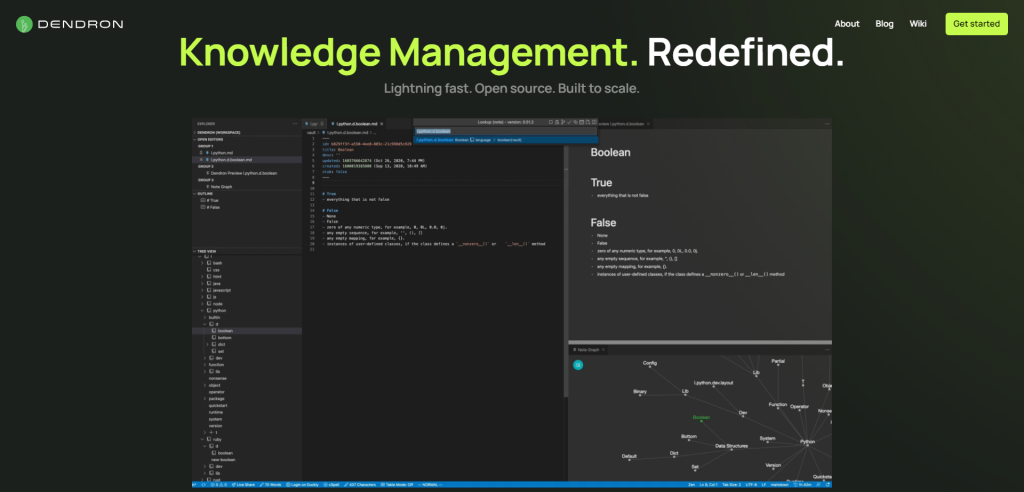
Dendron is a knowledge management tool that aims to redefine how information is organized and accessed. It is lightning-fast and open source, making it a flexible and scalable solution for teams and individuals.
One unique feature of Dendron is its use of schemas and templates to create consistently defined structures for general knowledge. This allows users to change their thinking without having to change their notes, providing a single source of truth for their information.
By using Dendron, teams can greatly enhance their productivity. With its lightning-fast search capabilities, users can quickly find the information they need with just a few keystrokes. The ability to cache everything ensures that all the relevant knowledge is readily available, eliminating the need to waste time searching through multiple sources.
Users have praised Dendron for its ability to centralize and organize their notes, thoughts, and project planning. They appreciate having a one-stop place for all their information, where they can feel at home while using their preferred code editor. Dendron’s hierarchical structure has been particularly helpful for users in organizing their notes effectively, providing them with the confidence to write freely and restructure later.
Trello
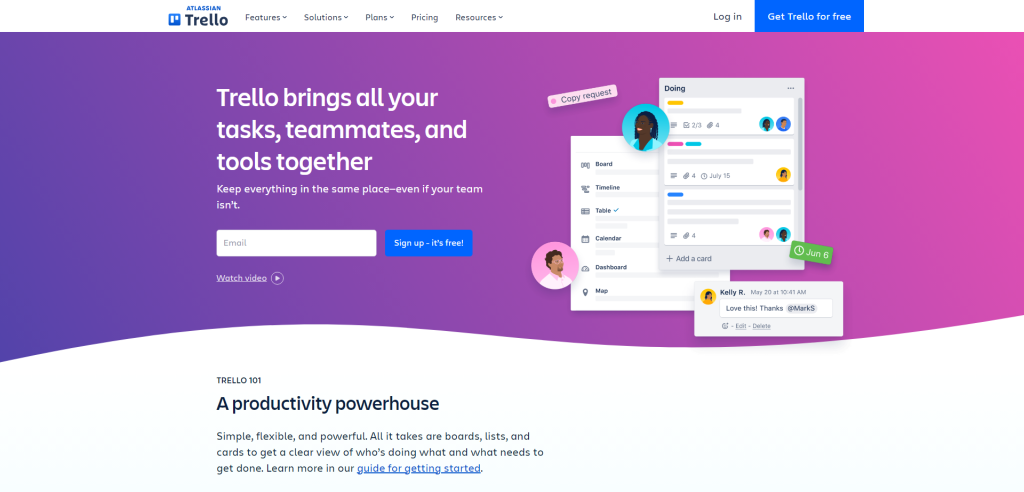
Trello is a powerful project management tool designed to help teams work better together. With its intuitive interface and flexible features, Trello makes it easy to organize tasks, collaborate with teammates, and keep projects on track. Whether you’re a marketing team launching a new product, an engineering team shipping code faster, or a remote team staying connected across different locations, Trello has features and templates to fit your needs.
What sets Trello apart is its visual approach to project management. Instead of complex spreadsheets or long email threads, Trello uses boards, lists, and cards to give you a clear view of who’s doing what and what needs to get done.
Boards act as the foundation, representing projects or initiatives, while lists help you organize tasks into different stages. Cards are then used to represent individual tasks or ideas and can hold all the information needed to complete them. As you make progress, you can easily move cards across lists to show their status.
Trello’s features go beyond task management. With views like Timeline and Calendar, you can get a bird’s-eye view of your team’s projects and stay on top of deadlines. Trello also offers integrations with other apps, allowing you to connect your favorite tools and streamline your workflow. Additionally, Trello’s Butler automation feature enables you to automate repetitive tasks, saving you time and effort.
👍 Pros
- Intuitive and visual interface for easy task management
- Flexible features and templates for different team needs
- Integrations with other apps and automation capabilities for streamlined workflows
👎 Cons
- Some advanced features may require a learning curve for new users
- Limited customization options for the visual layout
- Lack of built-in time tracking and invoicing features
Planka
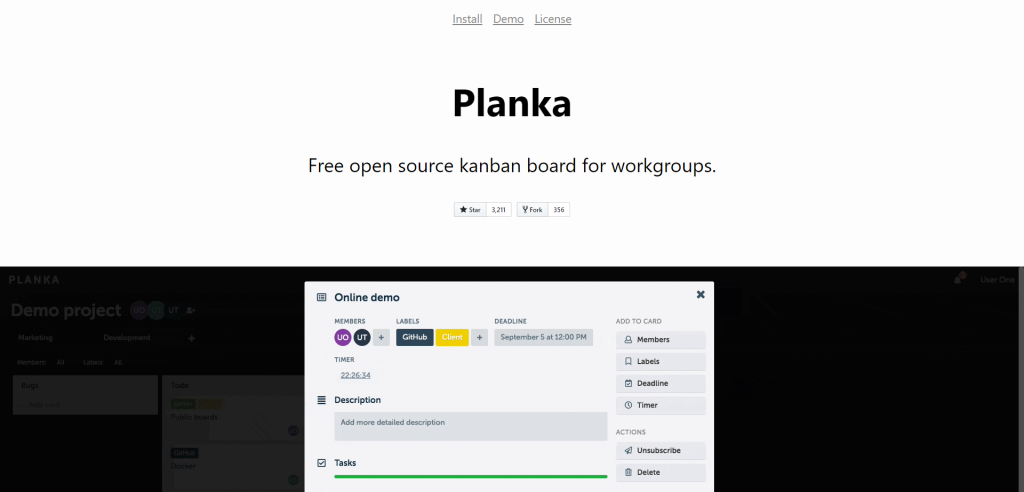
Planka (a self-proclaimed Trello alternative) is a fantastic tool for workgroups that value collaboration, organization, and simplicity. Unlike Trello, Planka is an open-source software, which means you can access its code, modify it, and contribute to the development of the platform. This gives you the freedom to customize the tool to fit your team’s specific needs. Plus, it’s free to use, so you can enjoy its powerful features without breaking the bank!
One of the standout features of Planka is its intuitive and user-friendly interface. It’s designed to be clean and straightforward, allowing you to create and manage boards, lists, and cards effortlessly. The drag-and-drop functionality makes it a breeze to move tasks between different columns, ensuring a smooth workflow. The simplicity of Planka makes it ideal for both small teams and large organizations.
Another unique aspect of Planka is the ability to set up multiple workgroups within the same instance. This means that you can collaborate with different teams or departments while keeping their projects separate and organized. Whether you’re working on marketing campaigns, software development, or any other project, Planka offers the flexibility to handle it all in one platform.
Now, let’s talk about how Planka can make teams more productive. With its kanban board layout, Planka gives you a clear visual overview of your tasks, allowing you to prioritize, allocate resources, and track progress efficiently. You can assign team members to specific tasks, set due dates, and attach files or comments to relevant cards. This level of organization and transparency helps teams stay focused, collaborate effectively, and meet their goals.
Planka also supports real-time updates, so team members can instantly see changes made by others. This promotes seamless communication and prevents any confusion or duplication of work. Additionally, Planka offers integrations with popular tools like Slack, allowing you to connect your work processes and streamline your workflow even further.
👍 Pros
- Free and open-source, providing flexibility and customization options.
- User-friendly interface with drag-and-drop functionality for effortless task management.
- Ability to set up multiple workgroups within the same instance for seamless collaboration.
👎 Cons
- Limited third-party integrations compared to some other Kanban tools.
- Customization options might require some technical knowledge for self-hosted instances.
- Not as feature-rich as some paid alternatives, but still offers a solid Kanban experience.
Taskcafe
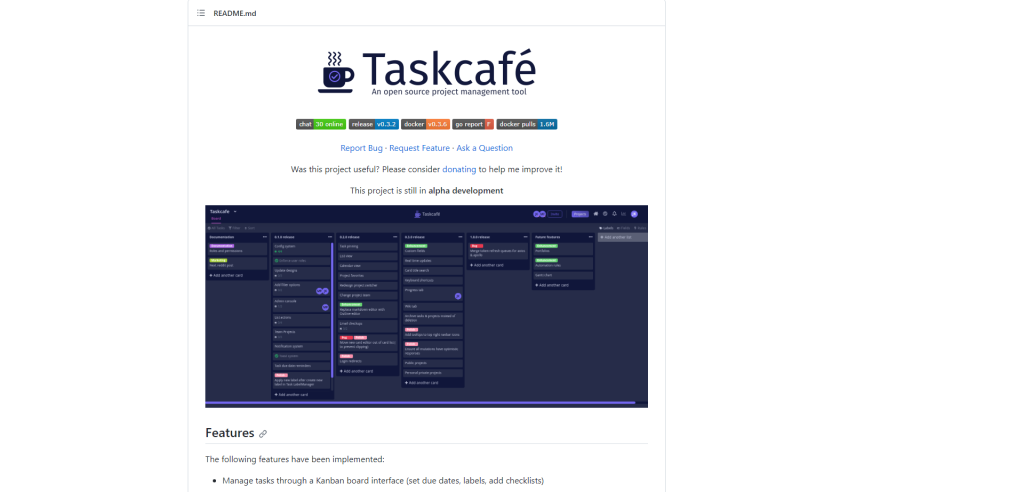
Taskcafe is an open-source project management tool with Kanban boards. It aims to provide a user-friendly interface and essential features for managing tasks and projects effectively. Taskcafe is different from other tools like Trello or NextCloud because its primary goal is to meet the requirements of the developer who created it. While it currently focuses on basic features that are common across project management tools, it plans to add more unique features in the future.
One of the advantages of Taskcafe is its open-source nature. This means that the community can contribute to its development, making it a collaborative and constantly improving tool. Users can join the Discord server to ask questions and seek guidance on how to use Taskcafe effectively. The community is active and provides support to help users make the most of the tool.
Taskcafe offers a range of features to enhance productivity. Users can manage tasks through a Kanban board interface, set due dates, assign labels, and add checklists. The “My Tasks” view allows users to see all their assigned tasks in one place, ensuring that nothing falls through the cracks. Additionally, users can collaborate on task comments and track the activity related to each task.
To install Taskcafe, there are two options available. For users who have Docker and Docker Compose installed, they can clone the repository, run the necessary commands, and access the tool via a local server. For those who prefer to build from source, they need to have Golang installed. After cloning the repository, running a few commands will compile the binary and install all the necessary dependencies. Users can then customize the configuration file and run the web interface.
Atlassian
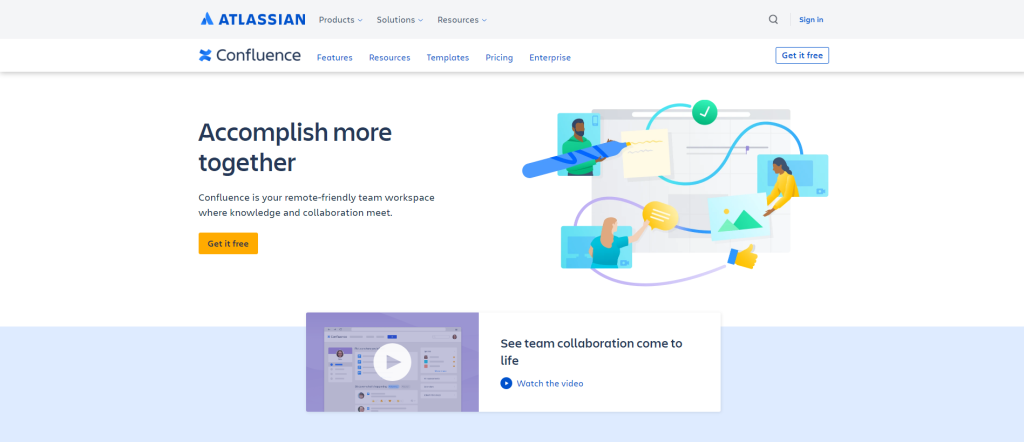
Atlassian stands out from the competition because of its comprehensive suite of tools that cover various aspects of collaboration. From project and issue tracking with Jira software to content collaboration with Confluence, Atlassian has all the bases covered. The integration between these tools allows for seamless collaboration across different teams and departments.
By providing a central hub for communication, task management, and file sharing, Atlassian eliminates the need for constant back-and-forth emails and meetings. Teams can collaborate in real-time, assign tasks, track progress, and share updates all in one place. This improves efficiency, reduces errors, and ensures everyone is on the same page.
However, there are a few cons to consider. Some users have reported that Atlassian can be overwhelming for new users, especially those who are not familiar with collaboration software. The initial learning curve can be steep, requiring time and effort to fully grasp all the features and functionalities.
Another drawback mentioned by users is the cost of Atlassian’s products. While they offer great value for larger teams and organizations, the pricing may be a bit steep for smaller businesses or startups with limited budgets.
Linear
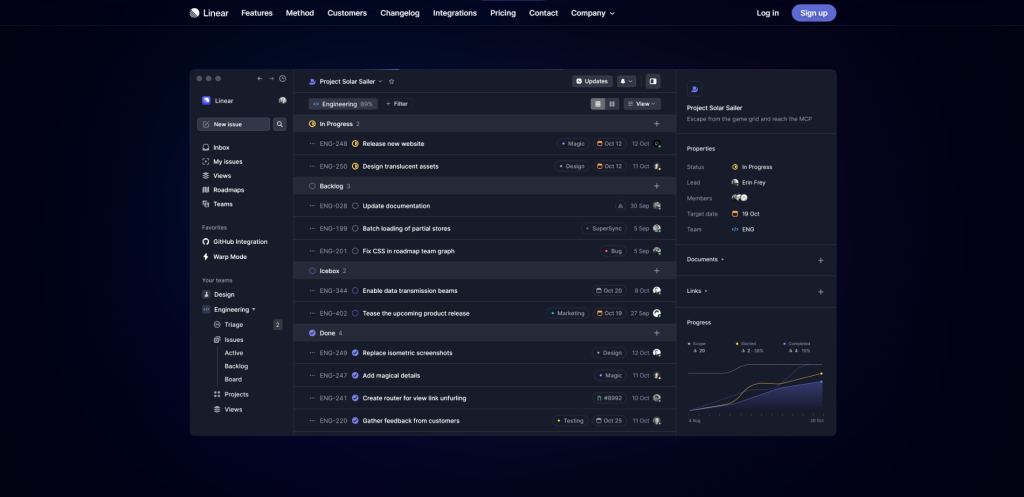
Linear is a next-generation tool that revolutionizes the way products are built. With its sleek design and precise engineering, Linear offers a unique user experience that combines UI elegance with world-class performance. This tool is designed to be intuitive and efficient, enabling teams to streamline their workflow and boost productivity.
What sets Linear apart is its focus on keyboard shortcuts. With a wide range of rapid-fire keyboard shortcuts, users can navigate through tasks and actions with lightning speed. This feature allows for a seamless and efficient workflow, making it easier than ever to complete tasks and collaborate with your team.
In addition to its speed, Linear is also built for performance. With 50ms interactions and real-time sync, this tool ensures that your work is always up to date and accessible from anywhere. Its fast and responsive interface enhances the user experience, allowing for a smooth and seamless workflow.
Linear also comes with built-in workflows that create focus and routine. With features like automated backlog, custom workflows, and discussion capabilities, teams can easily track and manage their work in a way that suits their unique needs. Whether you prefer the list or board layout, Linear offers flexibility to view and organize your tasks in a way that works best for you.
However, there are some cons to consider. Some users may find the learning curve steep when first starting out with Linear, due to its wide range of features and customization options. Additionally, while Linear offers integrations with popular tools like GitHub and Slack, some users may find that it lacks integrations with other third-party applications that they rely on for their workflow.
Summary
After wading through the sea of collaboration tools, it’s clear that there’s no one-size-fits-all solution. What works for a design team brainstorming on a virtual whiteboard might not be the best fit for a developer team that needs detailed task management. The key is to understand your team’s unique needs and workflow. From user-friendly interfaces to advanced project tracking features, each platform has its own strengths and weaknesses that can either boost your team’s productivity or hinder it.
To wrap things up, your choice of a collaboration platform isn’t a decision to take lightly. It’s more than just another piece of software; it’s where your team will spend a considerable amount of time communicating, managing projects, and sharing ideas. So go ahead, take those free trials for a spin, ask your team for their input, and really dig into what each platform can offer.






